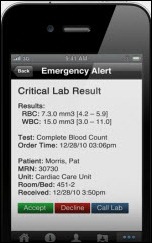Traditionally Professional Courtesy is something that physicians gave each other - but we had to be careful with it when…
News 12/30/11
Top News
CSC says it will have to write off almost the entire $1.5 billion it spent trying to install iSoft’s Lorenzo in the defunct NPfIT project in England. The government has apparently declined to give CSC the new scope of work the company had requested. CSC has also withdrawn its financial forecast and stepped up plans to replace its CEO. It posted a loss of almost $3 billion in its Q2 report filed September 30, mostly due to a write-down of goodwill. The company’s market cap is $3.7 billion. Shares are at $23.68, off more than half since the beginning of the year.
From Zafirex: “Re: hardship exemption for e-prescribing. Looks like so many providers are claiming it that CMS is having difficulties. Wonder how many are truly hardships? I doubt CMS could ever verify since it looks like they’re having trouble even producing a list.” Exemption categories include a practice area with no broadband coverage or that has too few participating pharmacies, practices that applied for Meaningful Use before requesting an exemption, practices that prescribe mostly narcotics that are not eligible for e-prescribing, practices that don’t prescribe regularly, or practices that e-prescribe but not for qualifying visits.
From Search Boy: “Re: searching HIStalk. Thanks for the explanation to King Salmon. Is there a way for retrieved searches to be indexed chronologically rather than as a percentage of keyword match?” I haven’t figured out how to do that. Since the pages are stored in a database, I don’t think the search function can determine the original publish date even though it’s in the title.
From Lilies: “Re: Epic. They’re #17 on the list of 25 oddball job interview questions, with ‘You have a bouquet of flowers. All but two are roses, all but two are daisies, and all but two are tulips. How many flowers do you have?’ There are two distinct valid answers.” Three is the obvious answer (one of each flower) that took me about two seconds to get. I assume the second answer depends on the question not stating explicitly that there are no other kinds of flowers in the bouquet (i.e., you could have two Venus fly traps only, making two a correct answer.)
From Stats Fan: “Re: readership stats. You haven’t given your readership stats lately for me to track.” Good timing since I realized a couple of weeks ago that I’ve been undercounting all along. I had forgotten to add the hit-counting Javascript to the mobile display that you see on iPhones and iPads. That hit me a couple of weeks ago, so I dug around the code and figured out how to fix it, also noticing that a surprising 30-50% of readers use Safari, most of them presumably on iPhones and iPads, which is a lot more mobile readers than I would have guessed. So far for December, it’s 96,250 visits, 148,218 page views, and 22,029 unique people reading (but that’s lower than the real number since I didn’t make the change until the middle of the month.) January and February will be good indicators since the HIMSS conference really pegs the needle on readership. Inga pays a lot more attention to the numbers than I do, so I will await her analysis. Above is where the visitors are from, just in case you are interested. Among cities, it’s Madison, Stone Mountain, Atlanta, New York, and Chicago making up the top five, but the major metro area is Boston with 8.41% of visitors. It’s a 62% male audience, so ladies, tell your friends.
From HIMSS Envy: “Re: HIMSS points. Got me wondering – it would be nice of HIMSS published an annual report for public review. It might not change a thing, but transparency is a powerful motivator. Come to think about it, Mr. H, how about you, too?” I thought HIMSS did a report, but I couldn’t find one. You can get their Form 990 from GuideStar, which always has interesting factoids (like that HIMSS FY 2009 revenue was $44 million and CEO Steve Lieber’s total compensation was $711K). I don’t know what I’d put in an annual report that isn’t already on the About page or contained in the list of sponsors … other than my hospital job, I don’t have any ownership in anything, I have no other income, and I don’t shill stuff like speaking or consulting under the delusion that I have value beyond what you’re reading right here.
From Peds Envy: “Re: tired of writing only good things about Epic. Private practice peds are the worst type of users for Epic. No surprise there. Someone who knows Brown & Toland told me the reaction is 100% unanimous – they hate it.”
From Anonymous Epic Fan: “Re: tired of writing only good things about Epic. Here are a few issues with their implementation methodology and support that even the Kool-Aid drinkers would have a hard time disputing.” Here’s the list from AEF:
- Epic’s implementation planning materials are weak. They have to be re-worked for each new application / scope mix, and after that is done, little to no effort is made by Epic to customize them based on organization specifics. If you want the project plan to be useful and to have sufficient detail, expect to spend a lot of time and effort re-working what gets initially delivered.
- Epic suggests you go live on Model workflows as quick as possible. As painful as it may be, it is definitely better from a cost perspective. Then, you plan to do the bulk of the ‘real’ implementation after getting live. This can/may work if the bulk of the existing documentation / orders workflows are paper based and you are implementing all of Epic’s applications, but this approach is suicide if the existing system being replaced has been customized for the end-users and they are happy with them or if you have to rely on the timelines of other vendors to build/test/implement interfaces and data conversions.
- The Epic Model does not work well for any hospital or outpatient units that are more complicated then the most typical med/surg units and general practice specialties. Specifically, hospital outpatient departments that bridge the inpatient and outpatient void.
- The Epic Model completely breaks down if you are not implementing all of Epic’s applications and workflows rely on interfaces to/from legacy systems.
- With Epic’s implementation team constantly turning over, being spread across more and more customers, and the increasing pressure to implement faster, attention to detail is lacking. In my experience, they are over promising and under delivering more than they did years ago.
- Time estimates are always low. Everything takes much longer than anyone anticipates. Medication build, consolidating charge masters, cleaning up supply/pick lists, mapping lab components, consolidating multiple sources of payor/plans, cleaning up the provider / credentialing information, getting physicians to agree and sign-off on order set/documentation template content, and working down duplicate patients in your EMPI or mapping data elements for conversions etc.
- Epic implementation tools / deliverables are often shared just before an upcoming trip for when they are to be used. Though effort is made to customize them based on application mix/scope, they never really get updated to reflect the actual workflows discussed and validated early in the process – especially if they differ in any amount from the ‘model’ workflow. The delivered product if very inconsistent from application team to application team and integrated areas/workflows often get overlooked. So just like the implementation planning materials, expect to spend a lot of time re-working these deliverables to make them useful.
- All application teams involved in the implementation are siloed, and in addition, the Epic implementation teams, technical support teams, and development teams are also siloed. This causes issues for organizations live on one set of applications, rolling out another set, and implementing a third set.
- The silos mean that there are application experts, but very few Epic staff have cross-application experience / knowledge and if workflows are interface-dependent, very few have true integration experience.
- Epic’s training only scratches the surface. The true training is the implementation process and go-live. The shorter the implementation timeline, the more unprepared the customer IT staff is to support the applications when they go live – thus the demand for lots of consultants.
- The system documentation is very inconsistent and virtually impossible to search on the UserWeb. Unless you know where to find what you are looking for, you often have to e-mail Epic to ask if documentation exists. I is not uncommon to be sent an ‘unofficial’ document created by a frustrated Implementer not being able to rely on the system administration guides themselves. In fact, all of the implementation documentation / guides were historically written and maintained by implementers, but due to the inconsistency between applications and un-sustainability of keeping it up to date. no implementation documentation/guides exist today.
- Epic’s end-user training materials are great if you are implementing all of Epic’s applications and you are using all Epic model workflows. If anything changes, these are not so great – expect to have to overhaul them.
- Same goes for the testing scripts. An OK start, but definitely not something that can be used out of the box.
HIStalk Announcements and Requests

How Apple wins customers for life: I had a five-year-old, first-generation, 1 GB Nano that I only used for the gym. I heard Apple was recalling a few of them because of some explosion-prone batteries, so I put in the serial number on their Web page and darned if mine wasn’t on the list. They sent a postage-paid Fedex box to return it. Today I got back a brand new sixth-generation, 8 GB Nano, which now comes with a color display, gestures, FM radio with live pause, pedometer/accelerometer, and a bunch of other features, all in a package barely bigger than a watch face (in fact, you can buy a watchband that holds it, turning it into a watch.) It’s super cool, and so is Apple. You did good, Steve Jobs – RIP.
It’s time to wrap up the HISsies nominations soon, so contribute yours now to the blank slate that will be distilled into a handful of choices for the real voting that starts shortly. I’m particularly happy with one nomination for Smartest Vendor Action Taken: “HIStalk sponsors that replaced blinking ads before the deadline.” Well done, and a good observation. My sponsors really are the best – as much as I hated to spring the change on them since it requires work and expense on their end, they’ve been great about it. I’ve enjoyed the nominees for the Beer and Pie categories, as always, and there are some good nominees for the Lifetime Achievement Award.
Speaking of the HISsies, full details and signups will go up next week for HIStalkapalooza in Las Vegas. And also speaking of the HISsies, if you plan to vote (and I hope you do), sign up for the e-mail updates since I e-mail the voting link out to prevent ballot box stuffing that was as rampant as in a third-world dictatorship until I took that step. For that reason, if you aren’t on the list, you can’t vote.
Listening: new from The Roots, which even though I’ve only sampled it so far due to limited time, is just blowing me away. It’s extraordinarily music in the form of a concept album, making it impossible to label as rap, soul, or hip hop even though it includes strong elements of all of those. The accompanying short film is here. Their talent is mind-boggling. Down it goes to the new Nano, which contains only my latest favorites since I intentionally started from scratch: Genesis And Then There Were Three, two albums from Gooder, one from Metric, and Luminiferous Ether by the never-gets-old Zip Tang.
It’s just Dr. Jayne and me tonight as Inga is sojourning in the mythical Land Without Broadband. She will return soon. But in the mean time, Dr. Jayne is doing her usual fabulous job. I’m pretty darned lucky to have two smart, funny, hard-working, and undeniably cute ladies with whom to share the page, don’t you think? I will raise a glass in their honor for New Year’s (probably of Duvel beer since I got some for Christmas and I like it a lot.)
I’m not telling you Happy New Year yet because I’ll be posting a Monday Morning Update this weekend as usual, even if nobody’s around Monday to read it.
Acquisitions, Funding, Business, and Stock
Board members and executives of document management vendor Streamline Health Solutions will buy $400K worth of the company’s stock, news of which sent shares up 9% on Wednesday.
Healthcare alerting system vendor Extension, Inc. announces what it says is record quarterly growth, adding 17 new hospitals in the third quarter and quadrupling its headcount to 40 over the past two years. They might want to budget for a public relations or media person next since this is easily one of the worst-written press releases ever, starting off with a clumsy opening sentence that sounds as though someone whose native tongue was not English (or at least not good English) sweated over it until nothing interesting remained. It doesn’t get better as you read on.
Announcements and Implementations

Tampa General Hospital (FL) goes live on its $120 million Epic system, which works out to $118K per bed. The hospital says $40 million of that was for hardware and software, with the rest going for staffing and training.
Other
Weird News Andy sounds like a fortune cookie in summarizing this story as, “Foot in mouth results in mouth in foot.” A man shows up in the ED with a swollen, infected foot, claiming he stepped on a piece of glass on the beach a couple of weeks before. The beach and timeline part of his story were accurate, but not the glass part: doctors removed a tooth embedded between his toes, lodged there during a beach fight when he kicked his opponent in the jaw while wearing flip flops.
Several readers were interested in John Halamka’s post about his wife Kathy’s newly diagnosed breast cancer. The first of regular updates, posted Thursday, is here. Reading his thoughts and analysis of their situation makes you realize that HIT stuff aside, he’s probably a fine doctor as well, not to mention the kind of supportive partner we would all want if faced with a life-changing diagnosis and gearing up to fight it.
A big health-related software sale you probably didn’t hear about: General Cannabis, which operates the medical marijuana dispensary finder WeedMaps, acquires MMJMenu, whose software for marijuana growers and dispensaries tracks inventory “from seed to sale,” basically an ERP for pot growers. General Cannabis had revenue of $10.4 million in the first nine months of the year and paid $4.2 million last month to buy the Marijuana.com domain.
John Newman, MD PhD, a UCSF physician and legal scholar, worries that medical copyrights will threaten patient care, citing a recent case in which a company offering a licensed cognitive screening tool threatened legal action against a similar but free online tool. The implication is that tools based on published research, which could be anything from a pain scale to a hip fracture risk predictor, could be claimed as proprietary by a fast-moving company. The author speculates that without new forms of copyrights, “… as physicians walk down the hallway interviewing patients, they’re tallying up the licensing fees they need to pay for doing their day’s work, and hospitals are suing each other or making cross-licensing arrangements to manage each other’s intellectual property.”
A power surge caused by monthly back-up generator tests at Aspirus Wausau Hospital (WI) takes all communication and computer systems down for five hours, forcing the hospital to go on ambulance diversion. As is always the case, the hospital says patient safety was never at risk, which you might interpret as meaning that those systems contribute nothing to patient safety. They’re on Epic, I believe, not that the hospital’s Wisconsin location didn’t already make that fairly likely.
GE Healthcare agrees to pay $30 million to CMS to settle a False Claims Act charge that it encouraged hospital and cardiology laboratories to overbill Medicare for Myoview, its form of technetium 99 that shows areas of decreased blood flow in the heart.
Sponsor Updates
- Rockford Orthopedic (IL) announces that 21 providers have successfully attested for Meaningful Use using eClinicalWorks EHR suite.
- Baptist Health Line (KY) receives its third ICARE award from RelayHealth for work with Western Baptist Hospital’s transfer center.
- Paul Rooke, CEO of Lexmark, discusses how the company’s acquisition of Perceptive Software and Pallas Athena puts them in a unique position in his interview with All Things D.
- Health Choice Arizona, achieves a 44% improvement in its completion rate for preventive services pilot program using MyHealthDIRECT.
- AmkaiSolutions will offer revenue cycle solutions from ZirMed to its outpatient surgery provider software customers.
EPtalk by Dr. Jayne
Where have all the drug reps gone? With significant cuts in the budgets for Big Pharma, many reps have been “made available to the workforce,” as they say. It seems hospitals and health systems are hiring former drug and device reps to sell their facilities to physicians. A recent article discusses how they’re using infection data and patient satisfaction scores to drive business rather than the drug pricing and formulary data of yore. In my book, this is just another thing that sucks up valuable time that we need to care for patients, not to mention sucking up budget dollars that could be better spent on those patients.
I wonder how many physicians who refuse to see drug reps also refuse to see these new “physician liaisons?” And how many health systems place rules around having these reps in the office? At some large integrated health systems, policies ban providers from seeing reps or liaisons from any facility or service provider that competes with a system-operated service line. This includes home health agencies, remote cardiac testing providers, reference labs, and the like. Other health systems restrict the hospital privileges of their employees (prohibiting credentialing at competitor hospitals,) so I’m not sure how big of a target pool these new reps have.
Weird News from one of my favorite places: South Carolina sports a giant mound of tires that can be seen from space. At least it’s not burning like the one in my favorite fictional town. But kudos to Lee Tire Company, Inc. of Jacksonville, Florida for waiving the usual fees to shred and recycle the tires in an attempt to clear the 50-acre mess.
Inga and I are well into our pre-HIMSS preparations. As you’re thinking about traveling to fabulous Las Vegas, consider this recent article that discusses continued concerns about backscatter scanners at the airport. Until I read this piece, I didn’t know they had been banned in Europe. As someone who has to wear a badge to track my exposure to radiation in the hospital, I do worry about frequent flyers. Many of my friends who work for vendors fly two to four times a week. There’s enough radiation from just being in a plane, let alone adding to it with scanners. I’d love to see the cumulative dose numbers for some of those flyers. Maybe frequent flyer programs should start issuing radiation monitoring badges with their airlines’ logos as a promotional item.
Each time I sit to write for HIStalk, I’m still amazed to be part of this team. It’s particularly amusing when I’m just reading through my “normal” e-mail and find a mention of us – most recently a blurb from MED3000 regarding Mr. H’s recent piece asking vendor leadership about the biggest HIT-related news items of 2011. I hope I don’t have facial leakage when I see these blurbs (yes, I have a bad habit of multitasking during meetings) because I know I feel like smiling.
Speaking of multitasking, one of my Facebook friends shared another article on docs multitasking during critical procedures. Medical schools are apparently having to actually instruct students to focus on the patient instead of the smart phone. Looking at some of the examples given in the article, it sounds like some IT teams need to revisit the websites they allow users to access. I can’t think of too many medically legitimate reasons to be on Facebook, Amazon, or eBay in the operating room or in the ICU.
I mentioned earlier this month about my inability to keep up with Inga where shoes are concerned. I think I win this round though – I seriously doubt that Santa left a glass slipper filled with Cosmopolitans at her house.
Have a question about managing pesky sales reps, maintaining the perfect poker face, or the best way to garnish a Cosmopolitan? E-mail me.
Contacts
Mr. H, Inga, Dr. Jayne, Dr. Gregg.













Stone Mountain is in top 5 cities for visitors to HIStalk? Considering I grew up there and graduated high school there, that makes me proud to be a Pirate. Message me directly for the words to the alma mater.
@AEF
Your list of Epic implementation issues is comprehensive and very well presented. However, I believe this list could be used for ANY software vendor delivering enterprise solutions – ECM/BPM, ERP and EHRs. Customers always complain about documentation not being customized enough – isn’t this what application / business analysts do – customize vendor documentation to fit the organization’s operational environment which they know best? The other issues you mention regarding implementation are usually indicative of poor PM on the customer side – resource management, LOE estimates, identifying inter-dependencies etc. In general, software vendors create tools that address a broad set of operational and business challenges. The vendor needs to make sure that the tools work as designed and that it is supported. It is the customer / organization’s responsibility to take ownership of the tool and used appropriately.
RE:AEF Thank you for speaking the truth to the power of the big E as it relentlessly grinds away. And thank you Mr. H. for running it. Such honesty is rarely seen and the courage to post rarer still. All the best in 2012.
“…The Epic Model completely breaks down if you are not implementing all of Epic’s applications and workflows rely on interfaces to/from legacy systems…”
Not sure I agree with the above comment. I’ve been involved in numerous implementations of a best of breed rehab software product that plays well with Epic and vice versa. Epic implementers don’t like it, and throw up all sorts of red flags to try to kill it, but they don’t have a solid rehab product..and when integrated with a product that excels there, everyone wins.
“honesty” and “courage”? Cripes. Even when a reasonable person posts a list of reasonable problems with Epic, people act like they deserve a medal. There’s no Epic gestapo out there; criticizing Epic isn’t any “braver” than criticizing any other vendor. Kudos to the list of reasonable problems though, much better than the usual lists of paranoid/inexplicably-rage-fueled half-truths about how Judy is a Commie Pinko. Just a heads up: Epic is not the damn USSR and criticizing it doesn’t warrant a round of self-congratulatory back-patting and talk of “speaking truth to power.”
RE: Epic
I have to say, those are all very good points criticizing Epic. I have not experienced every one of those issues, but I have been frustrated by many of them.
@ftn807
You make a good point that the issues that AEF mentions afflict all major vendors, but that still poses the question, “Why is Epic doing so well”?
I left Kaiser just before they implemented Epic. In speaking to some of my old doctor friends after the Epic go-live, they said the stress levels of working at Kaiser had increased 25% after the go-live. The main reason was a cumbersome user interface that significantly slowed clinical workflow. Kaiser’s answer was to schedule patients every 20 minutes instead of every 15 minutes like they did before Epic, but the doctors had to see the same number of patients everyday. In other words, providers must bear the burden. I also spoke to a very good PA I used to supervise while at Kaiser. She was fired along with many other mid-level providers because of the cost of Epic. At least that’s the explanation she gave me. So, the doctors were required to see even more patients.
The reason that Epic is the subject of so much commentary is that they are essentially achieving world domination with a very mediocre system with very mediocre support. They are selling a Ford Taurus at Ferrari prices and getting away with it. The question remains, “Why”?
AEF’s list is fairly accurate from my experience. I would say Epic tells you that Model is a starting point and that changes from model require updating of training materials, testing materials, workflow diagrams and support documentation. Some of Epic’s “tools” are more modifiable than others.
System documentation does vary but it is usually good in the mature modules and functions. It is not all that hard to find on Epic web but I would recommend downloading it locally and full text indexing it with SharePoint or Windows Desktop Search.
Silos are somewhat there but doing the following goes a long way: carefully selecting your staff on teams, letting them know you expect collaboration, and making it someone’s responsibility to handle collaboration/communications between team’s. Additionally, training staff across modules and setting-up integrated revenue cycle, clinical and reporting team sessions helps a great amount too. What you put into collaboration is what you get out – no secrets there – it is the same with any implementation.
A good deal of Epic’s implementation tools are available on Epic Web – do the due diligence and search them out. Also, having a good relationship with your Implementation Manager and Implementation Coordinators helps a great deal. Networking with other clients also helps – no secrets there – it is the same with any implementation.
Master data management as it is known in the rest of the technologically advanced world is always a challenge so spending the time there is very wise. I believe it is easier to start relatively from scratch where possible. Where it isn’t (ex: physician master), pick a place to start (ex: HIS, credentialing), do your due diligence on the data quality issues, and set the right data quality governance in place. Again, no secret. Just try and define a data warehouse without these basic tenets in place. Avoid throwing together a bunch of disparate masterfiles and then trying to sort them out (a la how you are stuck with defining an EMPI). EMPI’s take a ton of time regardless, you MUST identify the transactional data quality issues and address them. It is also wise to ramp-up with third party help.
Clinical content development is a bear with any system. That is no secret and it goes for any vendor. Networking with other like-minded organization is a good starting point but mapping all the different order items is another challenge (EMPI-like). The concern I always have is the reporting from all the disparate fields that spring-up with clinical documentation templates. Assigning some resources to managing this is a must. I have never seen this in anyone’s implementation methodology. Templates and order sets should go through a multi-discipline review process that includes quality, compliance, and revenue cycle. If you are linking-out to a supplies interface, including your smart people from supply chain is critical too.
Like any system, Epic has some areas with mature interface processing (ex: lab, rad) and some without (ex: detailed clinical documentation, plans of care). This is no different than any other vendor. The problem that exists in almost any system is when you integrate data flows from the biomedical devices outside of the basic information going into flowsheets. Some best-of-breed systems do this well but the big vendors rarely do. Challenging areas usually include anesthesia, eye care, OB, gastro, med. and rad. oncology, and cardiology. FORGET about registries – except for the real basics (ex: lab, encounters).
Model workflows are a starting point. Inpatient to outpatient transitions are not smooth in any system that I have seen. It requires work and compromise.
I find Epic’s success equally puzziling and truth be told all of the issues sighted by AEF seem true to me…..but until one of the big boys stops them there’s not much else to say…right now Epic is “winning” and “winning big”…..Still, one would think the cost overruns and the inability to be interoperable would have caught up to them by now…..but it hasn’t… so are CIO’s idiots, lemmings, lazy, or simply cowards? That is the real question?
Has anyone done a white paper on the impact to hospital and physician revenues AFTER implementing Epic? I’d love to see if there is an impact and how long it takes to recover?
@Pogo was right:
Epic is doing better because it has the best product, hands down. No company is perfect. By the way, I worked at Kaiser implementing Epic for almost 4 years… and I have to say the Epic implementation there was a stunning success. There were certainly a fair number of doctors who hated the system (and ANY change, in fact) but the majority seemed to like it and a fair share gushed about how much easier it made their lives.
I was not always a huge fan of Kaiser’s gigantic bloat while working there, but I have to say they certainly know how to roll out a product and they pull out all the stops. No project is perfect including that one, don’t get me wrong, but they rolled out a solid product extremely fast with mostly positive reviews from their users…. something that is not very easy to accomplish.
For the record, this was Ambulatory Epic implementation in Northern California – I can’t necessarily speak for other KP regions or teams as we were very silo’d.
So don’t try to hold it to that standard.
Epic tries to do the right thing whenever it can. It’s not always clear exactly what “the right thing” is some days, but that’s what it aspires to.
Epic get’s criticized for saying when it sees something that just isn’t going to work for customers.
At the end of the day, it is a free country and people in healthcare aren’t stupid lemmings as many AllScripts and McKesson sales people like to suggest on HIStalk comment posts.
Epic does a careful and considerate job for its customers and although not perfect, it is sincere in it’s approach.
I too was surprised to see Stone Mountain named, and even more surprised to see a fellow Pirate weigh in with his own amusement at the statistic. I’d love to find out if we went to school at SMHS around the same time. I’m always amazed at what a small world HIT can be.
(Mr. H, feel free to forward my email address on to Mr. Diggler, thanks.)